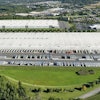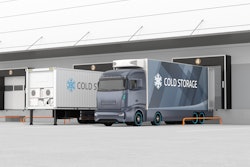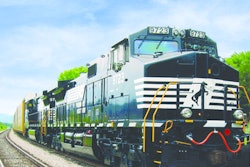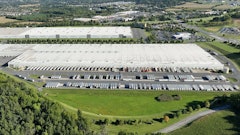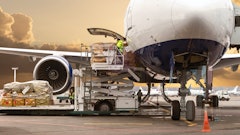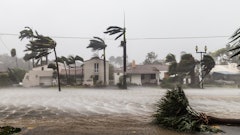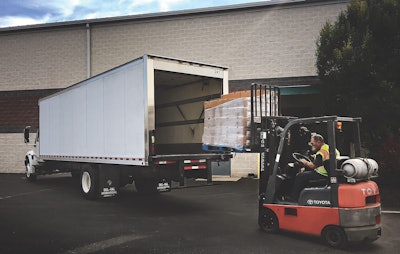
When natural disasters strike, the food logistics supply chain can come to a halt, severely impacting communities across the nation. Whether its hurricanes, wildfires, or even winter storms, these severe weather events can knock out critical energy infrastructure and create unique challenges for food logistics operations that can’t afford downtime.
That’s where propane is stepping in to support food logistics operations before, during, and after the storm as a portable, reliable, and scalable energy solution. This resilient energy helps power the supply chain equipment that moves food quickly and safely when it matters most. Backed by a community of propane industry professionals that mobilize when natural disasters strike, propane is prepared to keep the food logistics supply chain running.
Prepare with propane
When a storm is on the horizon, the food supply chain must ramp up. Ports, warehouses, and distributors need to jump into action to move goods, replenish shelves, and meet spikes in demand.
Propane-powered equipment makes that surge response possible. Terminal tractors, forklifts, and delivery trucks help scale up productivity and accelerate operations in the critical days leading up to a storm. Unlike diesel, which can gum up engines or require stabilizers, propane can be stored on site and doesn’t degrade over time, so it’s there and ready when it’s needed most. And when energy needs increase, propane suppliers are a phone call away for additional deliveries.
Propane-powered material handling equipment also requires less preparation and can be up and running faster than other energy sources in the days before a storm. While electric material handling equipment requires lengthy charging cycles, propane-powered equipment is quickly refueled at the swap of a cylinder or at the pump with similar refueling times to gasoline or diesel vehicles. This allows logistics professionals to efficiently maximize equipment use without increased downtime.
Whether it’s pushing more containers through a port, increasing product flow through a distribution center, or mobilizing trucks to restock stores, propane enables food logistics operations to move faster and more efficiently so communities can prepare.
Supply chain continuity
Once the storm hits, propane remains a dependable energy source for food logistics professionals. While power outages leave battery-electric applications stranded, and gasoline and diesel stations disabled because they require electricity to pump and distribute the fuel, propane doesn’t face those issues. During disruptions, food logistics professionals can work with their local supplier to have a propane bobtail delivery vehicle on-site to provide fuel and maintain a reliable energy supply during times of greater need.
This is especially important at ports or in warehouses where handling perishable foods is critical. Terminal tractors move containers from ships to cold storage, while forklifts ensure continuous material handling at the warehouse. Propane forklift cylinders deliver full power throughout an eight-hour shift, maximizing productivity. And because propane is a clean energy source that meets or exceeds national indoor air quality standards, it can safely be used both indoors and outdoors, unlike gasoline or diesel. That makes propane forklifts especially valuable for facilities trying to maintain product flow while recovery efforts continue.
Once goods are ready to ship, propane-powered delivery trucks add a layer of resiliency into any food logistics operation. With a range of up to 400 miles and the payload capacity required for food and beverage distribution, these delivery trucks can maintain operations and restock communities immediately following a disaster. Additionally, while fuel prices for gasoline and diesel may surge following a severe weather event, fleet owners that use propane autogas aren’t subjected to those pricing fluctuations. In many cases, fleet owners can work directly with their propane suppliers to secure fuel contracts that help shield them from unpredictable price swings.
Disaster recovery operations
In the aftermath of a storm, food logistics operations must quickly recover to minimize lost product and stabilize supply chains. In the recovery phase, propane is there as a dependable and flexible energy source for essential systems, like powering mobile refrigeration units or temporary kitchens. It can help maintain food sensitive storage and support food handling operations until systems are fully restored.
For large energy users like warehouses and distribution centers, propane also helps reduce strain on the electric grid when it’s at its most vulnerable. Following a storm, utility companies prioritize hospitals, emergency centers, and critical infrastructure. By diversifying energy sources with propane, food logistics operations can reduce electricity demand and continue operating independently, all while alleviating system stress during recovery.
In many recovery scenarios, propane can also fuel safety equipment like mobile light towers, heaters, and mobile appliances. When powered by propane, they can operate off-grid, making them especially valuable in areas where access to electricity may be cut off for long periods. For logistics hubs that operate around the clock, this kind of availability is critical to speeding up repair work and restoring normal service.
Recovery is much more than just cleanup. It’s about getting product moving again, and propane enables a faster, safer return to operations across the food supply chain.
Propane in action
Beyond just being a resilient energy source for every phase of disaster response, the propane industry also consistently shows up to support food logistics businesses and the communities they serve.
In late 2024, after Hurricane Helene left communities without power across the Southeast, 36 propane-powered bobtail delivery trucks provided much-needed energy supply. This helped businesses, emergency responders, and food operations maintain power for cooking, refrigeration, and facility support despite widespread infrastructure damage. Propane-powered generators also filled more than 5,000 grill cylinders in the first eight days after the storm.
Meanwhile, nine tractor trailers filled with more than 12,000 propane cylinders were used to provide power to appliances for lighting, cooking, and generators to communities in Georgia, North Carolina, and South Carolina.
A few months later and on the other side of the country, a propane provider stepped in to support CAL FIRE’s mobile kitchen unit during the January Los Angeles wildfires. The company provided propane to power the kitchen infrastructure at the command center, ensuring first responders had access to hot meals.
These responses show how propane is a vital resource in disaster situations because it’s portable, reliable, and backed by an industry committed to supporting the communities they serve.
Ready for the next storm
As the food logistics sector continues to harden its systems against disruptions from severe weather events, propane is quietly working in the background to power the systems that keep food moving. Whether it’s fueling delivery trucks, energizing backup systems, or cooking meals, propane consistently proves its value. As natural disasters continue to strike, propane’s ability to adapt, respond, and deliver makes it an essential asset in any food logistics resilience strategy.


